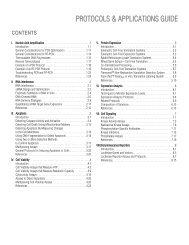Cloning Protocols and Applications Guide-A4 format - Promega
Cloning Protocols and Applications Guide-A4 format - Promega
Cloning Protocols and Applications Guide-A4 format - Promega
Create successful ePaper yourself
Turn your PDF publications into a flip-book with our unique Google optimized e-Paper software.
||||||||||||| 13<strong>Cloning</strong><br />
Table 13.2. Colony PCR using GoTaq® Flexi DNA<br />
Polymerase.<br />
Components<br />
Nuclease-Free Water<br />
(to a final volume of<br />
50µl)<br />
5X Reaction Buffer<br />
dNTP mix (10mM of<br />
each dNTP)<br />
GoTaq® DNA<br />
polymerase (5u/µl)<br />
25mM MgCl2<br />
Downstream screening<br />
primer<br />
Upstream screening<br />
primer<br />
Boiled colony<br />
supernatant<br />
Volume<br />
Xµl<br />
10µl<br />
1µl<br />
0.25µl<br />
3µl<br />
50pmol 1<br />
50pmol 1<br />
5µl<br />
Final<br />
Concentration<br />
1X<br />
0.2mM each<br />
0.025u/µl<br />
1.5mM<br />
1µM<br />
1µM<br />
1 A general formula for calculating the number of nanograms of<br />
primer equivalent to 50pmol is: 50pmol = 16.3ng × b; where b is<br />
the number of bases in the primer.<br />
5. Amplify the target DNA using cycling conditions<br />
appropriate for your screening primers <strong>and</strong> size of<br />
amplimer (see Table 13.3 for suggestions). Place<br />
reactions in a thermal cycler that has been preheated<br />
to 94°C.<br />
Table 13.3. Suggested Amplification Conditions.<br />
Time<br />
Step<br />
Temperature (minutes) Cycles<br />
Initial<br />
denaturation<br />
94°C<br />
2<br />
1<br />
Denaturation 94°C 0.5–1.0 25–35<br />
42–65°C 0.5–1.0<br />
1<br />
Annealing<br />
Extension<br />
Final<br />
extension<br />
Soak/Hold<br />
72°C<br />
72°C<br />
4°C<br />
1 minute/<br />
kilobase 2<br />
5<br />
Indefinite<br />
1 Annealing temperature should be optimized for each primer set<br />
based on the primer melting temperature (Tm). To calculate melting<br />
temperatures of primers in GoTaq® Reaction Buffer, go to BioMath<br />
Calculators.<br />
2 The extension time should be at least 1 minute per kilobase of<br />
target. Typically, amplimers smaller than 1kb use a 1-minute<br />
extension.<br />
6. Remove an aliquot of the completed PCR <strong>and</strong> analyze<br />
by agarose gel electrophoresis for the product of<br />
appropriate size, which indicates the correct insert is<br />
present in the clone.<br />
<strong>Protocols</strong> & <strong>Applications</strong> <strong>Guide</strong><br />
www.promega.com<br />
rev. 1/12<br />
1<br />
1<br />
7. Recommended: Culture the appropriate colony or<br />
colonies to create a glycerol stock of your recombinant<br />
plasmid or plasmids, <strong>and</strong> purify the plasmids in larger<br />
quantities [e.g., PureYield Plasmid Systems (Cat.#<br />
A2492, A2495)] for downstream applications or further<br />
manipulation.<br />
D. Subcloning<br />
Classic subcloning involves restriction digestion of the<br />
plasmid of interest to remove the desired DNA fragment<br />
followed by ligation into a second vector with compatible<br />
ends. PCR can be used for subcloning as well, amplifying<br />
the insert from one plasmid <strong>and</strong> cloning the product into<br />
a T vector. Alternatively, the PCR product can be generated<br />
using primers with restriction enzyme sites, cut with the<br />
appropriate enzymes, then cloned into a vector with<br />
compatible ends. Further in<strong>format</strong>ion on subcloning can<br />
be found by visiting the Subcloning Notebook.<br />
IV. <strong>Cloning</strong> Protocol for the Flexi® Vector Systems<br />
A. PCR Primer Design, Amplification <strong>and</strong> Cleanup<br />
The desired protein-coding region must be amplified by<br />
PCR before being cloned into the Flexi® Vectors<br />
(Figures 13.6 <strong>and</strong> 13.7). The optimal conditions for<br />
amplifying the protein-coding region will depend on the<br />
DNA template, DNA polymerase, PCR primers <strong>and</strong> other<br />
reaction parameters. We recommend following the protocol<br />
provided with the DNA polymerase to generate the PCR<br />
product. For protein-coding regions less than 700bp,<br />
consider using GoTaq® DNA Polymerase to amplify your<br />
protein-coding region. For regions greater than 700bp, we<br />
recommend the use of a high-fidelity DNA polymerase,<br />
such as Pfu DNA polymerase. To facilitate cloning, the PCR<br />
primers used to amplify the protein-coding region must<br />
append an SgfI site <strong>and</strong> a PmeI site to the PCR product. To<br />
append these sites, incorporate an SgfI site in your<br />
amino-terminal PCR primer <strong>and</strong> a PmeI site in your<br />
carboxy-terminal PCR primer. Transfer of protein-coding<br />
regions into N-terminal Flexi® Vectors results in<br />
translational readthrough of the SgfI site, which encodes<br />
the peptide sequence Ala-Ile-Ala. The PmeI site is placed<br />
at the carboxy terminus, appending a single valine residue<br />
to the last amino acid of the protein-coding region. The<br />
valine codon, GTT, is immediately followed by an ochre<br />
stop codon, TAA. Primer design guidelines are provided<br />
in Technical Manual #TM254 <strong>and</strong> the Flexi® Vector Primer<br />
Design Tool.<br />
To cleanup the PCR product, refer to Amplification,<br />
Analysis <strong>and</strong> PCR Cleanup.<br />
PROTOCOLS & APPLICATIONS GUIDE 13-14

















